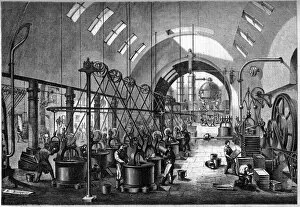Assembly Line Work Collection
"Revolutionizing Production: The Rise of Assembly Line Work" Step inside the Waltham Watch Factory in the United States
All Professionally Made to Order for Quick Shipping
"Revolutionizing Production: The Rise of Assembly Line Work" Step inside the Waltham Watch Factory in the United States, where innovation and efficiency merge to transform manufacturing forever. Through intricate engravings, witness the birth as it revolutionizes industries across the globe. In c. 1750-1850, an interior view of a Printing House showcases early signs of this groundbreaking method. Workers collaborate seamlessly, each assigned specific tasks along the production line. This engraving serves as a glimpse into how division of labor paved the way for increased productivity. Venturing beyond borders, we find ourselves at the Port of Naples captured in exquisite gouache on paper. Here too, assembly line work thrives as goods are unloaded swiftly and efficiently from ships onto awaiting carts – a testament to its universal appeal. Across England's vast landscapes, large industries such as Walter Evans cotton spinning plant in 1863 embrace this transformative approach. Witness workers skillfully maneuvering machinery while wire wrapping threads with precision – an art form that propels textile production to new heights. But it is not just textiles that benefit from this industrial evolution; construction workshops for sawmills become major players in 19th-century economies worldwide. These bustling hubs showcase how assembly line work extends its reach beyond traditional manufacturing sectors. Delving deeper into sugar refining processes reveals Launay's grand refinery owned by Mr. , serving as a prime example of large-scale industry adopting assembly line techniques. From raw materials to refined sweetness, every step meticulously executed by specialized workers ensures optimal output and quality. As we journey back to Walter Evans' cotton spinning plant once more through multiple engravings capturing its magnitude and influence, one cannot help but marvel at how assembly line work becomes synonymous with progress itself. These glimpses into history remind us that behind every great industry lies an army of dedicated individuals working together like cogs in a well-oiled machine – their collective efforts shaping the world we know today.









